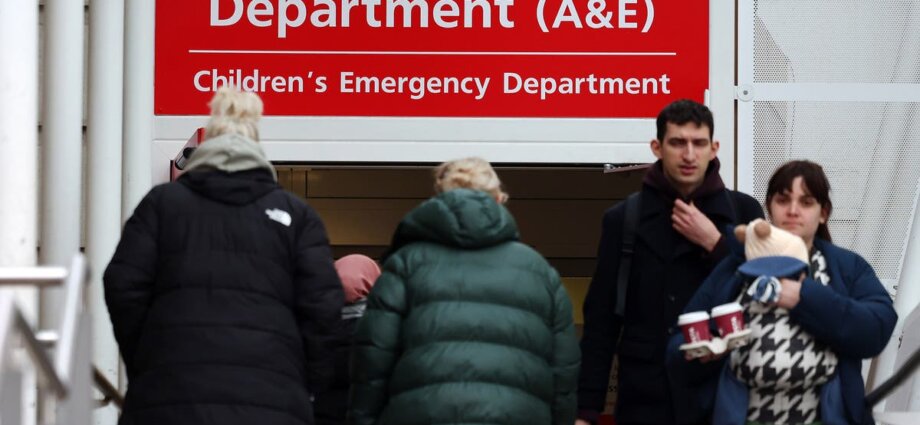England’s top doctor has warned staff in hospitals are facing conditions similar to the “height of the pandemic” amid a national surge in flu cases on wards.
NHS figures reveal there were an average of more than 5,400 patients with flu in hospitals each day last week, up 21 per cent from the previous week and more than three times the level seen at the same point last year.
Visits to A&E also rose to an unprecedented level for December, making last year the busiest ever year for emergency departments.
With around 20 NHS hospital trusts declaring critical incidents over the past week, many are now urging people to only use A&E in life-threatening emergencies, while The Independent has spoken to patients who witnessed long waits on emergency wards.
Professor Stephen Powis, the national medical director for NHS England, said: “It is hard to quantify just through the data how tough it is for frontline staff at the moment – with some staff working in A&E saying that their days at work feel like some of the days we had during the height of the pandemic.”
“It is clear that hospitals are under exceptional pressure at the start of this new year, with mammoth demand stemming from this ongoing cold weather snap and respiratory viruses like flu – all on the back of 2024 being the busiest year on record for A&E and ambulance teams,” he added.
Have you been affected by this? email [email protected]
His colleague, Professor Julian Redhead, NHS national clinical director for urgent and emergency care, said flu cases were “skyrocketing”.
The pressure on hospitals was illustrated on Thursday by Gloucestershire Hospitals NHS Foundation Trust taking the decision to discharge 140 patients to cope with “extreme winter pressures”.
The trust is one of several which have declared critical incidents – meaning demand has outstripped capacity and patients will face long waits if they attend.
A spokesperson for the trust, which runs hospitals in Gloucester and Cheltenham, told The Independent: “Declaring a critical incident allows the NHS in Gloucestershire to take additional, immediate steps to create capacity, help discharge patients, relieve pressure on the emergency departments and also release ambulances and their crews.”
Other trusts have been restricting visitors and asking people to wear facemasks to avoid the spread of the flu.
Alex Blyth told The Independent he spent 12 hours at A&E at University Hospital Monklands in Airdrie, Scotland on Wednesday after being sent for a chest X-ray by his GP.

He said: “On entering A&E the waiting room was full with people standing. I was then taken for a chest X-ray and was then left in a wheelchair in a corridor next to the treatment area.
“I was told this was to ease the A&E area. I waited two hours before being found again and taken for a CT scan. After that, there was another few hours of waiting until I got my results and was finally allowed home.”
Louise, who does not want to give her full name, managed to get a bed in A&E at Morriston Hospital in Swansea, Wales on Christmas Eve – but was aware that the ward was full and no one else could get in.
She said: “The nurses were absolutely amazing, but it was a case of there being no spare beds in the hospital to move people from A&E to another ward, and because there were no spare beds in the hospital A&E was full.”
A spokesperson for Swansea Bay University Health Board, which runs Morriston Hospital, said: “Overall demand in the emergency department has been considerably higher this winter than last, with almost 550 more attendances in the emergency department last month compared to December 2023.
“The situation has been exacerbated by high levels of flu and other respiratory illnesses. As a result of these combined pressures, it is not always possible to find ward beds as quickly as we would like despite the best efforts of staff.”
Thursday’s figures showed that the average number of flu patients in English hospitals had risen for a sixth week in a row, and last week’s figure of 5,408 a day was nearly five times the number on 1 December, when the total stood at 1,098.
The figure was also more than three times higher than at this point last winter – when the average was just 1,548.
The data further showed that almost half of patients (42 per cent) arriving by ambulance at hospitals last week waited at least 30 minutes before they were handed over to A&E teams.
Sarah Arnold, senior policy lead at The King’s Fund, said: “With depressing predictability, health services are in the depths of the annual NHS winter crisis.
“There are already reports of patients waiting more than two days to be seen in A&E, long ambulance handover delays, and critical incidents have been declared at hospitals up and down the country. The consequence is that patients are being cared for in unsuitable conditions such as trolley beds in hospital corridors.”
The interim chief executive of NHS Providers, Saffron Cordery said: “Winter has been brutal so far for the NHS and we’re not out of the woods yet. Things are likely to get worse before they get better.”
Health secretary Wes Streeting said: “Annual winter pressures should not mean an annual winter crisis, which is why this government is making significant investment in the NHS, undertaking fundamental reform, and acting now to improve social care.”











